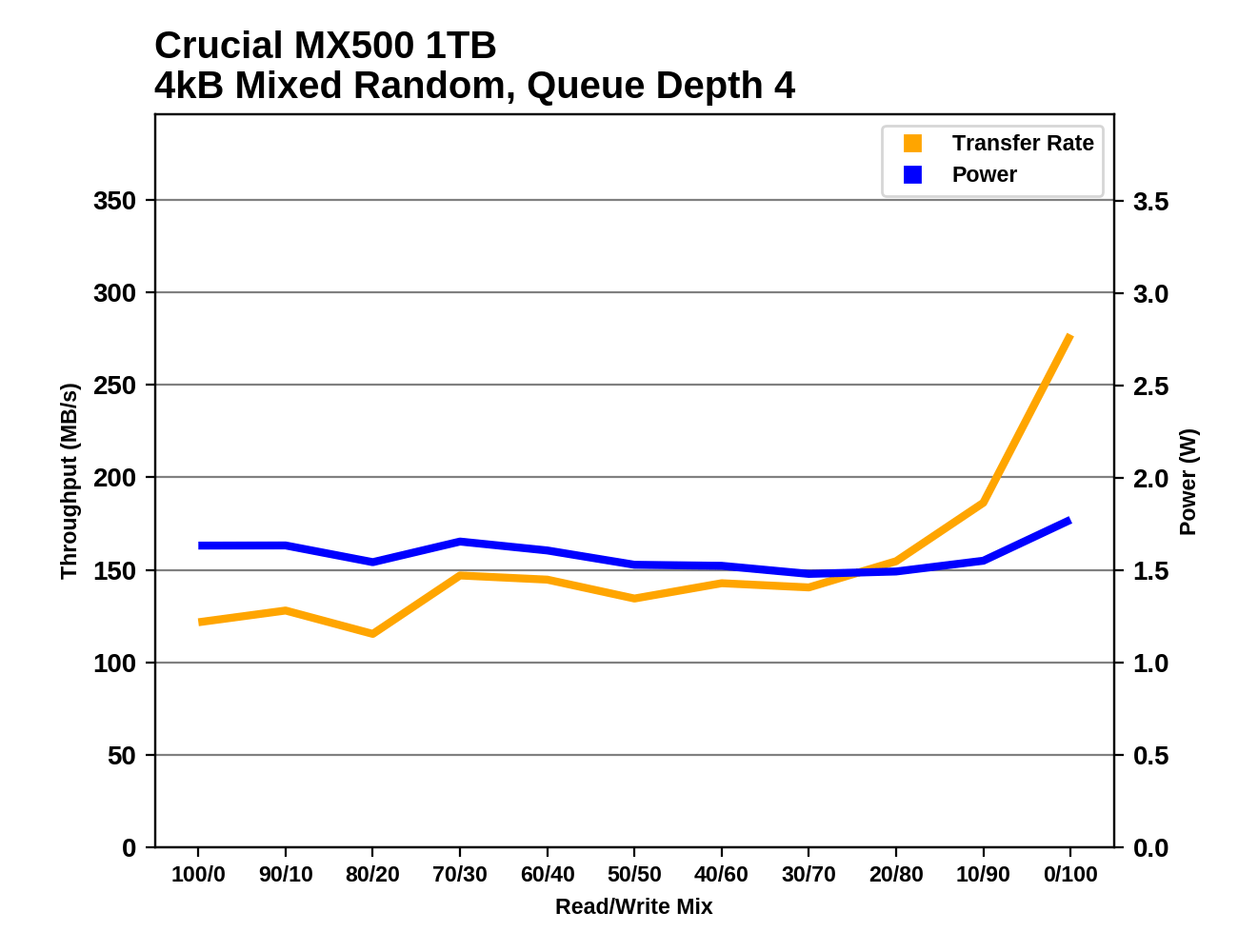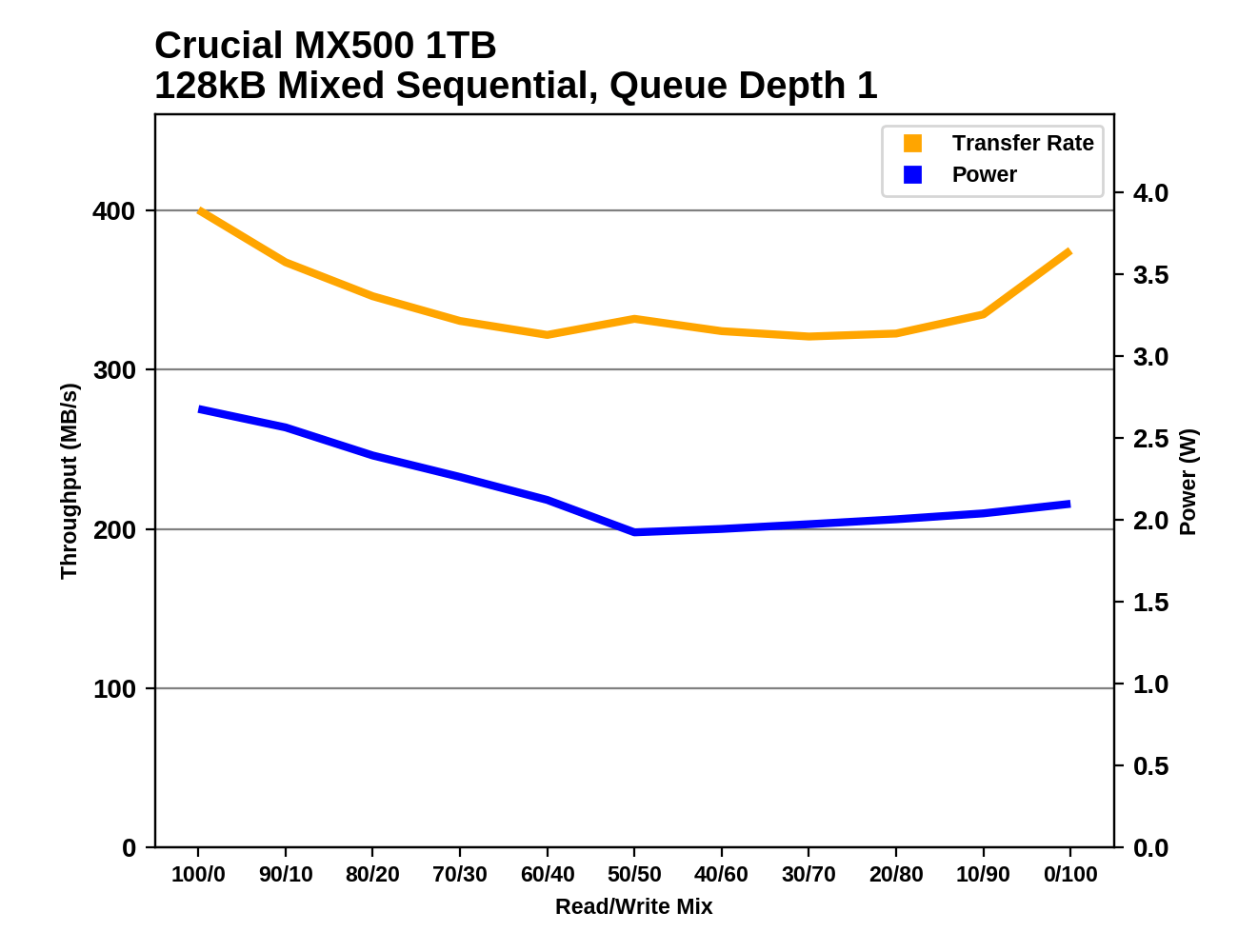The Crucial MX500 1TB SSD Review: Breaking The SATA Mold
by Billy Tallis on December 19, 2017 8:00 AM ESTMixed Random Performance
Our test of mixed random reads and writes covers mixes varying from pure reads to pure writes at 10% increments. Each mix is tested for up to 1 minute or 32GB of data transferred. The test is conducted with a queue depth of 4, and is limited to a 64GB span of the drive. In between each mix, the drive is given idle time of up to one minute so that the overall duty cycle is 50%.

The mixed random I/O performance of the Crucial MX500 is slightly slower than both the MX300 and the Intel 545s, but still above average for mainstream SATA SSDs. The 64L 3D TLC drives from Toshiba and Western Digital/SanDisk are significantly slower, and the Samsung 850 PRO and 850 EVO are still the fastest for this test.

The Crucial MX300 and Intel 545s are tied for first place for power efficiency on this test, with the MX500 coming in third place and well ahead of the other mainstream SATA drives.
 |
|||||||||
The Crucial MX500's performance during this test is a bit unsteady but generally good during the first half when the workload is more read-heavy. The MX500's speed picks up significantly when the workload becomes very write-heavy, but it take too long to start speeding up; other drives like the Samsung 850 PRO and EVO are steadily accelerating with increasing proportion of writes, starting fairly early in the test.
Mixed Sequential Performance
Our test of mixed sequential reads and writes differs from the mixed random I/O test by performing 128kB sequential accesses rather than 4kB accesses at random locations, and the sequential test is conducted at queue depth 1. The range of mixes tested is the same, and the timing and limits on data transfers are also the same as above.

The Samsung 850 PRO and EVO are the fastest SATA drives on the mixed sequential I/O test, and the Crucial MX500 falls into the second tier of drives, along with the other mainstream 64L 3D TLC drives and the MX300.

The Toshiba TR200 and OCZ VX500 score highest on power efficiency for the mixed sequential I/O test because they include little or no DRAM. The MX500 scores reasonably well overall but worse than the MX300 and the Intel 545s.
 |
|||||||||
The Crucial MX500 performs well in the early, read-heavy phases of the test but performance drops toward the middle and only recovers slightly at the end of the test. The minimum performance level across the entire test is quite high, but the fastest drives spend much less time performing at or near their minimum.










90 Comments
View All Comments
peevee - Tuesday, December 19, 2017 - link
"SMI controllers tend to be more popular for budget products"... "Silicon Motion has been working to improve their controllers and move toward the high end, but the MX500 isn't even adopting the newer SM2259"... "but they're not as large or numerous as on previous MX series drives"race to the bottom.
MajGenRelativity - Tuesday, December 19, 2017 - link
Did you look at the improved performance numbers? I'm not sure how that supports a race to the bottomWolfpup - Tuesday, December 19, 2017 - link
Ugh, is EVERYONE using TLC now? I was uncomfortable enough with MLC.I'm not crazy about switching away from Marvell either...though I suppose as long as it works and the software Micron writes is good...
I really want a higher end MLC (or SLC!) drive from Crucial/Micron.
My main system is still using a 2012 Crucial drive though. It literally launches programs in maybe 1-2 seconds MAX, so who the heck cares if it were 42x faster? (Literally the only time I've ever see it take any actual time to respond to anything was when I was doing something else while running TRIM on it for no real reason.)
But my next drive I'd like to be MLC Crucial/Micron too...
MajGenRelativity - Tuesday, December 19, 2017 - link
BX300 is your best betsmilingcrow - Tuesday, December 19, 2017 - link
Don't waste your time with SLC but look at Optane.MajGenRelativity - Tuesday, December 19, 2017 - link
That's another alternativevalinor89 - Tuesday, December 19, 2017 - link
Optane is a first gen product... I think I will pass this round and watch for the next generations .Also, Optane is not in the same price range as "conventional" SSD.
extide - Wednesday, December 20, 2017 - link
It's a bit higher but not outrageous by any means. It's FAR cheaper than several of the early SSD's I bought in terms of $/GB. Frankly for its performance, I think it's priced pretty aggressively, TBH.DanNeely - Tuesday, December 19, 2017 - link
SLC is dead in anything except very non-mainstream products (eg low capacity embedded flash built on a process so large that even doing ECC is optional), at only 1/3 the density of TLC per chip it's nowhere near cost competitive. The same factor is killing off MLC as 3d TLC improves. I suspect over the next year or three MLC flash will gradually fade away too.If they can get the total write count up high enough, QLC will start displacing TLC over the next few years. That number was only a few dozen writes a few years ago; I haven't seen any updates since then. OTOH over similar timespans TLC write endurance has climbed from a few hundred writes to a few thousand; if QLC has been able to improve equally we might start seeing it soon in entry level products.
jjj - Tuesday, December 19, 2017 - link
You seem to have a negative opinion on 3D TLC for no good reason while also not requiring much perf.If your current drive is from 2012, a Crucial m4 that was fashionable back then, has 72TB endurance while the this MX500 has 360TB for the 1TB version and 180TB for the 500GB.version.